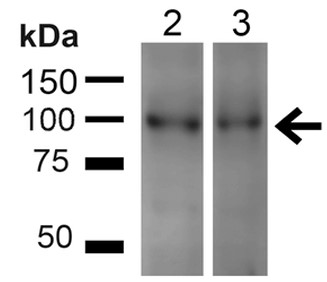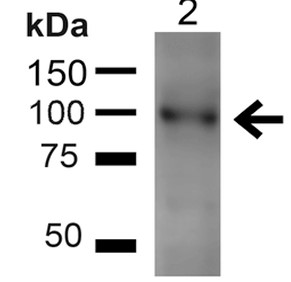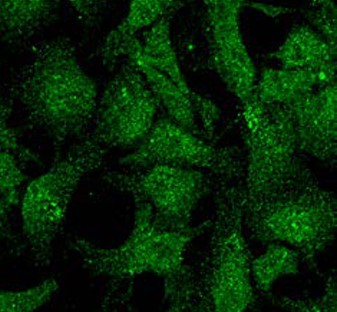Anti-UVRAG Antibody (23013)
Anti-UVRAG Antibody (23013)
Product No.: 23013
- -
- -
Clone p63 Target UVRAG Formats AvailableView All Product Type Polyclonal Alternate Names p63 Applications ICC , IF , WB |
Data
- -
- -
Antibody DetailsProduct DetailsReactive Species Human ⋅ Rat Host Species Rabbit Immunogen Synthetic peptide corresponding to mid-protein amino acids of human UVRAG. Product Concentration 1.0 mg/ml Formulation PBS, pH 7.4, 50% glycerol, 0.09% sodium azide.Concentration: 1mg/ml State of Matter Liquid Product Preparation Purified by Protein A affinity chromatography Storage and Handling This antibody is stable for at least one (1) year at -20°C. Regulatory Status For in vitro investigational use only. Not for
use in therapeutic or diagnostic procedures. Country of Origin USA Shipping Next Day 2-8°C Applications and Recommended Usage? Quality Tested by Leinco Immunoblotting: use at 1- 2ug/mL. A band of ~75- 90kDa is detected.
Immunofluorescence: use at 10ug/mL. These are recommended concentrations. Endusers should determine optimal concentrations for their applications. Each investigator should determine their own optimal working dilution for specific applications. See directions on lot specific datasheets, as information may periodically change. DescriptionDescriptionSpecificity This antibody recognizes human and rat UVRAG. Background Autophagy is a catabolic process that results in the degradation of bulk cytoplasmic contents within autophagosomes and lysosomes. UV radiation resistance-associated gene product (UVRAG) is a protein localized in the endoplasmic reticulum (ER) and endosomes and is known to regulate autophagosome maturation as well as early stages of autophagy. UVRAG regulates autophagosome maturation by binding to the homotypic fusion and vacuole protein sorting (HOPS) complex, which consists of the class C Vps complex (Vps11-Vps16-Vps18-Vps33) and two additional proteins, Vps39 and Vps41. UVRAG binding to the HOPS complex stimulates lysosomal fusion with autophagosome and endosome. Function Versatile protein that is involved in regulation of different cellular pathways implicated in membrane trafficking. Involved in regulation of the COPI-dependent retrograde transport from Golgi and the endoplasmic reticulum by associating with the NRZ complex; the function is dependent on its binding to phosphatidylinositol 3-phosphate (PtdIns(3)P) (PubMed:16799551, PubMed:18552835, PubMed:20643123, PubMed:24056303, PubMed:28306502). During autophagy acts as regulatory subunit of the alternative PI3K complex II (PI3KC3-C2) that mediates formation of phosphatidylinositol 3-phosphate and is believed to be involved in maturation of autophagosomes and endocytosis. Activates lipid kinase activity of PIK3C3 (PubMed:16799551, PubMed:20643123, PubMed:24056303, PubMed:28306502). Involved in the regulation of degradative endocytic trafficking and cytokinesis, and in regulation of ATG9A transport from the Golgi to the autophagosome; the functions seems to implicate its association with PI3KC3-C2 (PubMed:16799551, PubMed:20643123, PubMed:24056303). Involved in maturation of autophagosomes and degradative endocytic trafficking independently of BECN1 but depending on its association with a class C Vps complex (possibly the HOPS complex); the association is also proposed to promote autophagosome recruitment and activation of Rab7 and endosome-endosome fusion events (PubMed:18552835, PubMed:28306502). Enhances class C Vps complex (possibly HOPS complex) association with a SNARE complex and promotes fusogenic SNARE complex formation during late endocytic membrane fusion (PubMed:24550300). In case of negative-strand RNA virus infection is required for efficient virus entry, promotes endocytic transport of virions and is implicated in a VAMP8-specific fusogenic SNARE complex assembly (PubMed:24550300). {PubMed:18552835, PubMed:20643123, PubMed:24056303, PubMed:28306502, PubMed:22542840}. NCBI Gene Bank ID UniProt.org Research Area Autophagy References & CitationsTechnical ProtocolsCertificate of Analysis |





